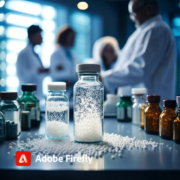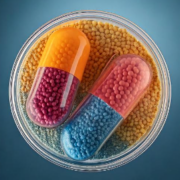This study investigated fixed-bed columns for methylene blue removal. It evaluated CELLETS®, a granulated spherical cellulose material, as an adsorbent in the system [1]. CELLETS® 200 has useful properties, including perfect sphericity, narrow particle size distribution, low friability, and chemical inertness. Experiments used a dye solution (9–10 mg/L, pH 4.7) with different flow rates. We modeled dynamic adsorption using the Thomas and Yoon–Nelson models. Results showed an optimal flow rate above 0.01368 m³/day per gram of adsorbent. Adsorption capacities ranged from 1.375 to 3.303 mg/g. These findings confirm that CELLETS® 200 is effective for wastewater treatment targeting organic dyes.
Introduction: fixed-bed column techniques & challenges of dye removal
Fixed-bed column adsorption is widely used in water purification. In this process, contaminated fluid passes through a packed column of adsorbent material. First, the process forms a saturated front zone, and then a sharp adsorption zone (mass transfer zone) develops. As a result, this design allows continuous or semi-batch operation. Moreover, it is favored for cost-efficiency, scalability, and ease of integration into industrial setups. Thus, compared to batch processes, it performs better in real-world applications.
However, removing synthetic dyes like methylene blue remains challenging. This is because these compounds have complex aromatic structures, high stability, and resist biodegradation. Consequently, conventional treatments often fail. In particular, in pharmaceutical and textile industries, dye contamination can compromise product safety and interfere with downstream processes. It also raises environmental and regulatory concerns, especially due to strict effluent purity standards in drug manufacturing. Therefore, developing effective, robust, and regenerable adsorbents is essential.
Use of CELLETS® 200 in this study
The publication “Fixed‑Bed‑Column Studies for Methylene Blue Removal by Cellulose CELLETS®” investigates CELLETS® 200 as a novel adsorbent. CELLETS® are granulated spherical cellulose with several advantages. They have near-perfect sphericity, narrow particle-size distribution, low friability, and chemical inertness. These features ensure predictable column hydraulics, low pressure drop, and resistance to mechanical breakage. Such attributes are essential for reliable fixed-bed media.
Experimental setup
-
Column configuration: A lab-scale glass column was packed with CELLETS® 200 beads.
-
Feed Solution: Aqueous methylene blue dye (9–10 mg/L), pH ~4.7.
-
Operational variables: Volumetric flow rate, bed height, and influent dye concentration were systematically varied.
-
Modeling approaches: Breakthrough data were analyzed using two classic dynamic models:
-
Thomas model – assumes plug flow and Langmuir-type kinetics;
-
Yoon–Nelson model – which simplifies predictions of breakthrough time tied to the probability of adsorption and breakthrough .
-
Key findings
The study identified key findings on CELLETS® 200 in fixed-bed column adsorption of methylene blue. Higher flow rates caused faster breakthrough times. This reduced the contact between dye molecules and the adsorbent, lowering overall adsorption efficiency. Lower flow rates and taller bed heights extended contact time. This improved dye removal and delayed breakthrough. CELLETS® 200 showed adsorption capacities from 1.375 to 3.303 mg of dye per gram of adsorbent. These values indicate consistent, moderate uptake suitable for treating dilute dye solutions. Experimental data matched the Thomas and Yoon–Nelson kinetic models. This suggests the models can reliably describe dynamic behavior under different operating conditions. The study established an optimal flow rate above 0.01368 m³/day per gram of adsorbent. This threshold ensured efficient dye removal and manageable hydraulic conditions in the column.
Conclusion & outlook
This study, “Fixed-Bed-Column Studies for Methylene Blue Removal by CELLETS”, shows that CELLETS® 200 granules are promising for continuous removal of low-concentration organic dyes like methylene blue. Their physical robustness and predictable hydraulics make them suitable for industrial wastewater applications. The adsorption capacities are moderate but sufficient for tertiary or polishing stages in effluent treatment. They are especially useful in pharmaceutical processes, where dye levels are often in the low mg/L range.
Outlook & Future Directions:
-
Regeneration and reuse: Future work should address desorption protocols and adsorbent longevity—critical for economic and environmental sustainability.
-
Real wastewater testing: Performance in multi-component, real industrial effluents (e.g., pharmaceutical or textile waste streams) needs to be validated to confirm efficacy under complex matrix conditions.
-
Scale-up studies: Pilot-scale trials will help translate lab-scale findings to full-scale operations, where factors like channeling, pressure drops, and extended service life become significant.
-
Material modification: Surface functionalization (e.g., with charged or reactive groups) may enhance uptake and selectivity, improving performance against a broader range of dyes.
In summary, this research highlights CELLETS® 200 as a viable, solid-phase adsorbent for low-level dye removal in dynamic systems. With further development in regeneration, real-world testing, and scaling strategies, it holds strong potential for integration into modern industrial wastewater treatment frameworks.
References
[1] Iulia Nica, Gabriela Biliuta, Carmen Zaharia, Lacramioara Rusu, Sergiu Coseri, Daniela Suteu, Environmental Engineering and Management Journal, 2020, Vol.19, No. 2, 269-279. online Link



 adobe firefly
adobe firefly 

 adobe firefly
adobe firefly 

